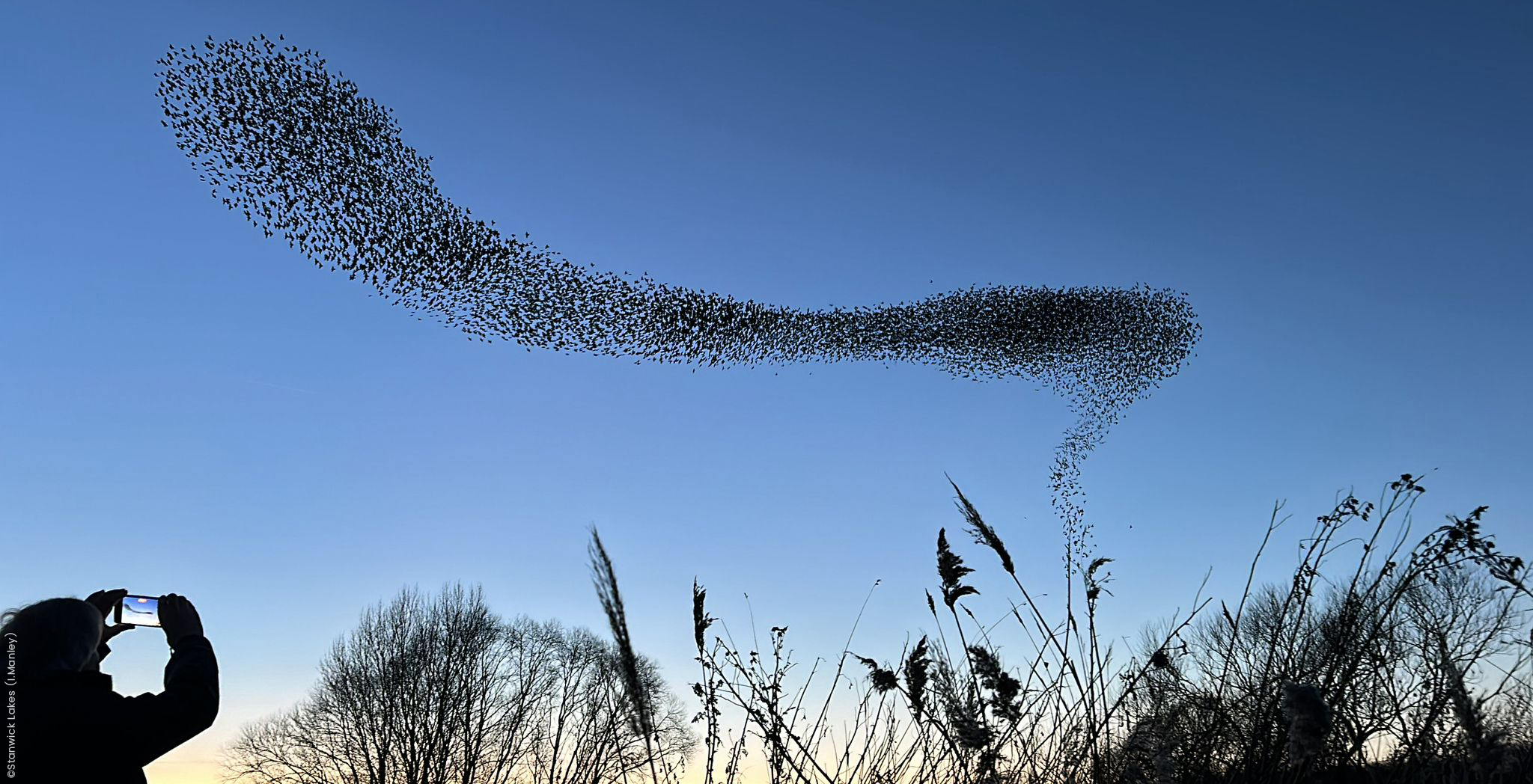Stanwick Lakes, renowned for its picturesque lakes and swaying reed beds, has set the stage for a breathtaking natural phenomenon – a mesmerizing starling murmuration.
Nestled in the heart of the Nene Valley, the nature reserve has observed significant starling numbers and some murmurations during January, turning its reed beds and numerous lakes into a theatre for nature’s aerial ballet. Covering 750 acres, this wetland site provides an ideal habitat for starlings to roost – and perform – creating a captivating spectacle for both seasoned birdwatchers and casual visitors alike.
Quote from Ranger Michelle:
“Having worked in conservation in some incredible places throughout the UK and beyond, I’ve been lucky enough to see some magnificent wildlife. Throughout though, a starling murmuration has always been irrefutably at the top of my wildlife list. To be able to see such a spectacle on our doorstep is magical and I feel unbelievably lucky to work at Stanwick Lakes to see this.”

Understanding the Magic:
Starling murmurations are a breathtaking display of aerial acrobatics, which occur when large flocks of these birds swoop and swirl together in an intricate dance before settling into their evening roost. There is no definite answer as to why these birds behave in this way, but it is thought by many experts that it might be a tactic to deter and discombobulate predators, gaining safety in numbers, and to stay warm.
Of course, as with many elements of nature, murmurations can be spontaneous and unpredictable, and there is no guarantee of their occurrence, adding an element of delightful unpredictability to the birdwatching experience. The remainder of this blog observes what has been seen so far…
The Dance Begins:
Usually occurring between the months of November and March, at dawn and dusk, the first whispers of this awe-inspiring spectacle emerged of an evening in the first week of the year. Our regular birders reported starlings sporadically dancing over Alder Lake and Auroch Lake, but scattered sightings and adverse weather conditions hindered visibility.

However, having experienced some clearer skies, larger numbers have been observed at both ends of the reserve, firstly at the north-west end of the reserve, with an incredible murmuration over the reedbeds, observed from one of the bird hides adjacent to Sandpiper Lake, as well as from Sandmartin Bridge, over Brightwater and back over Alder Lake. With changeable weather set to continue, we’re hopeful the breathtaking display will reoccur in good viewing conditions and it will be possible to enjoy from pathways around the reserve. We invite you to help us keep track and document any sightings – as numbers could still build whilst migrating birds join, and later leave in around March.
Quote from Ranger Issac:
“Getting to capture magical moments in nature is such a gift that my job here has made possible every day. Documenting the work we do as rangers and moments like these is one of the many ways I can help engage visitors with the natural world around them. We are truly so very lucky to have experiences like these here at Stanwick Lakes and what once seemed like “once in a lifetime” spectacles are now something I get to be a part of regularly at work”

Monitoring the Gathering: Numbers and Anomalies
Local birders have been diligently monitoring the murmuration, estimating a presence of around 20,000 starlings. But this celestial dance in the skies is not limited to starlings; once a gathering builds, it can disturb crows, jackdaws, and even the lapwings here. In turn, birds of prey, including peregrines, sparrow hawks, and occasionally harriers, are drawn by the commotion.
Currently, the murmurations at Stanwick Lakes seem haphazard, sometimes scattered, and unpredictable – just as the birds intend! They have been seen flying along the water’s surface and close to the ground, and due to the low flight path, they can be difficult to see and may even go unnoticed at times.

While the birds do gather for roosting each evening, they may do so in numerous smaller groups, and in different locations. Displays can build in numbers and movement gradually, so be patient. On the other hand, those smaller groups may make a sudden descent to a roost site without putting on much of a display. Either way, it is wonderful to see health numbers of Starlings in the county.
We ask that visitors interested in the spectacle keep on eye on the skies and let us know of any sightings of starlings, and in particular, murmurations, so that we can add them to a ‘murmuration map’ – and collect any photos you are happy to share for a “Stalring Scrapbook” – please leave details of what you observe at the visitor centre, email us, or @mention us on social media.
Please manage your expectations, and don’t be disheartened if you travel to witness a grand display in the sky, only to find nothing obvious unfolds. Take in the calm, look out for other roosting visitors such as Redwing, Fieldfare and all three types of Egret that can be seen at Stanwick Lakes, and take in the sounds of this wetland habitat.
Keep an eye on the weather, as good conditions can offer a beautiful sunset, which can be equally rewarding.

Conservation Concerns:
Despite their incredible displays, in what appear to be dense numbers, starlings the UK Red List due to concerns about declining populations. Encounters like these underscore the importance of preserving their habitats and raising awareness about their conservation needs.
Quote from Volunteer Colin:
Volunteering regularly at Stanwick Lakes gives me an insight into how the habitat changes with the seasons, serving wildlife in various ways at different times of the year. It is so rewarding to be part of the team who cares for the environment here, which just so happened to place me perfectly to experience this wonderful spectacle at just the right time.”
How to Enjoy a Murmuration Responsibly:
To fully appreciate a murmuration while respecting the birds and their habitat, visitors to Stanwick Lakes are kindly urged to:
– Stick to paths and trails. Please do not enter reed beds or water.
– Avoid irresponsible or illegal parking. Please consider using our car park (and our lovely café) which both support the charity’s operations.
– Pop in to the Visitor Centre and speak to the team, or chat to a Ranger for the latest starling sightings and advice for spectating.
– Help us shape a ‘Starling Scrap Book’ by sharing your observations and any photos, and build “Murmuration Map” – just speak to a member of the team with details of what you see!
Closing Thoughts:
Please note, for anyone visiting specifically to observe starlings at the nature reserve, it is worth bringing a waterproof/protective layer. As starlings flyover, they may deposit their lunch! Activity currently takes place anytime between 4-5pm, dependent on weather an conditions. The Visitor Centre and facilities close at 5pm, and the carpark is locked promptly at 5.30pm, whilst winter hours are in operation.
For those who want to know more about Stanwick Lakes, the birds that visit or overwinter, and any other wildlife to be found here, please visit our website or follow Stanwick Lakes on social media platforms.









